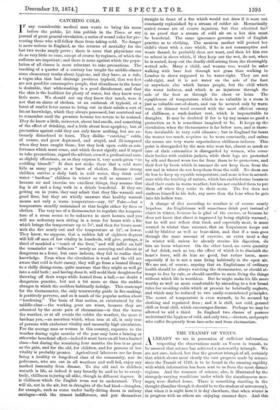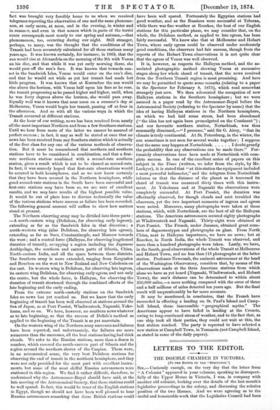THE TRANSIT OF VENUS.
ALREADY we are in possession of sufficient information., respecting the observations made on Venus in transit, to be assured that science has achieved a noteworthy triumph. We are not sure, indeed, but that the greatest triumph of all, certainly that which shows most clearly the vast progress made by science since the Transit of 1769, is to be found in the amazing rapidity with which information has been sent to us from the most distant regions. And the romance of science, also, is illustrated by the strangely-varying conditions under which the simultaneous mes- sages, were flashed home. There is something startling in the thought (familiar though it should be to the student of astronomy), that when it is night here it is day elsewhere, that when winter is in progress with us others are enjoying summer days. And this
fact was brought very forcibly home to us when we received telegrams reporting the observation of one and the same phenome- non, at early morn, at noon, and in the evening, in winter and in summer, and even in that season which inparts of the torrid zones corresponds most nearly to our spring and autumn,—that phenomenon, too, occurring during our night. Still stranger, perhaps, to many, was the thought that the conditions of the Transit had been accurately calculated for all these stations many years ago. It was known certainly, for instance, in 1869, that the sun would rise at Alexandria on the morning of the 9th with Venus on his disc, and that while it was yet early morning there, she would pass off the sun's face. It was known that towards sun- set in the Sandwich Isles, Venus would enter on the sun's disc, and that he would set while as yet her transit had made but little progress. It was known that at Kurrachee the sun would rise above the horizon, with Venus half upon his face as he rose, the transit progressing as he passed higher and higher, until, when he was forty degrees above the horizon, she would pass away. Equally well was it known that near noon on a summer's day at Melbourne, Venus would begin her transit, passing off at four in the afternoon. And so with all the various ways in which the Transit occurred at different stations.
At the hour of our writing, news has been received from nearly all the most important Northern and from a few Southern stations. Until we hear from more of the latter we cannot be assured of perfect success ; in fact, it may as well be stated at once that no news has been received from any Southern station which is actually of the first class for any one of the various methods of observa- tion. But it must be remembered that northern and southern stations have to be considered in combination, and that a first- rate northern station• combined with a second-rate southern station, gives a result which is not to be classed as second-rate. In fact, it was scarcely hoped that first-rate observations would be secured in both hemispheres, and as we now know certainly that they have been secured in the Northern hemisphere, while good second-rate stations in the South have been successful and first-rate stations may have been so, we are sure of excellent results, and we may have results of the highest possible value. It would be out of place here to discuss technically the value of the various stations where success or failure has been recorded. The following general account will suffice to show how matters stand at present.
The Northern observing army may be divided into three parts : —A north-eastern wing (Delislean, for observing early ingress), extending as far as the Sandwich Isles in that direction ; a north-western wing (also Delislean, for observing late egress), extending as far as Suez, Constantinople, and Moscow towards the west ; and a central force (Halleyan, for observing lengthened duration of transit), occupying a region including the Japanese Archipelago, the southern and eastern parts of Siberia, China, North-eastern India, and all the space between these districts. The Southern army is more extended, ranging from .Kerguelen and Bourbon on the west to New Zealand and New Caledonia on the east. Its western wing is Delislean, for observing late ingress, its eastern wing Delislean, for observing early egress, and not only the centre, but the whole force, is Halleyan, for observing the duration of transit shortened through the combined effects of the late beginning and the early ending.
From the extreme north-easterly stations on the Sandwich Isles no news has yet reached us. But we know that the early beginning of transit has been well observed at stations around the Sea of Japan, as at Port Possiet, Wladiwostock, Nagasaki, Yoko- hama, and so on. We have, however, no southern news whatever as to late beginning, so that the success of Delisle's method as applied to the beginning of the Transit is as yet uncertain.
On the western wing of the Northern army successes and failures have been reported, and unfortunately, the failures are more numerous than the successes, all the best stations having had thick clouds. We refer to the Russian stations, more than a dozen in number, which covered the south-eastern part of Siberia and the region around the northern shores of the Caspian. These were, in an astronomical sense, the very best Delislean stations for observing the end of transit in the northern hemisphere, and they were not only provided for the most part with excellent instru- ments, but some of the most skilful Russian astronomers were stationed in this region. We find it rather difficult, therefore, to understand why the Astronomer-Royal should have said, at the late meeting of the Astronomical Society, that these stations could be well spared. In fact, this would be truer of the English stations in Egypt, though we should not have been well pleased to hear Russian astronomers remarking that these British stations could have been well spared. Fortunately the Egyptian stations had good weather, and as the Russians were successful at Teheran, while there was fine weather at Roorkee, the beat of our English stations for this particular phase, we may consider that, on the whole, the Delislean method, as applied to late egress, has been fairly successful. We know also that at Melbourne and Hobart Town, where early egress could be observed under moderately good conditions, the observers had fair success, though from the reports of the Hobart Town observations it is not quite clear that the egress of Venus was well observed.
It is, however, as respects the Halleyan method, and the as- sociated photographic method showing Venus at successive stages along her whole chord of transit, that, the news received from the Northern Transit region is most promising. And here we may be permitted to quote some remarks (relating to a paper in the Spectator for February 8, 1873), which read somewhat strangely just now. We then advocated the occupation of new Halleyan stations in the Southern hemisphere ; but we were assured in a paper read by the Astronomer-Royal before the Astronomical Society (referring to the Spectator by name) that the idea of having Halleyan stations in the Northern hemisphere, on which we had laid sonde stress, had been abandoned (" the idea has not again been promulgated on the Continent ") ; and our favourite northern station, Nertschinsk, was thus summarily dismissed,—" I presume," said Sir G. Airey, "that its climate is truly continental. At St. Petersburg, in the winter, the sun sometimes is not seen for several weeks together ; I suppose that the same may happen at Nertschinsk. I doubt greatly the probability that any observations can be made there." For- tunately observations have been made at Nertschinsk with com- plete success. In one of the excellent series of papers on this subject in the Times (written, we infer from the, style, by Mr. Lockyer), it is stated that " at this station the equipment included a most powerful heliometer," and the telegram from Nertschinsk informs us that the distance of the planet as it traversed its chord of transit was measured thirty times with this instru- ment. At Yokohama and at Nagasaki the observations were completely successful. At Port Possiet, the duration was effectually observed, for though clouds and mist troubled the -observers, yet the two important moments of ingress and egress were noted. Moreover, many photographs were taken at these stations, which, with Nertschinsk, are the best of all the Halleyan stations. The American astronomers secured eighty photographs at Wladiwostock and Nagasaki. Thirty-eight were obtained at Port Possiet. The French, under Janssen, obtained great num- bers of daguerreotypes and photographs on glass. From North, China, next in Halleyan importance, we have no news ; but at Roorkee, in North India, the whole Transit was observed, and more than a hundred photographs were taken. Lastly, we have, in the South, good observations of the whole Transit at Melbourne and Hobart Town, and no less than 113 photographs at the latter station. Professor Newcomb, the eminent astronomer at the head of the Washington Observatory, considers that, by means of the observations made at the three American stations from which alone we have as yet heard (Nagasaki, Wladiwostock, and Hobart Town), the sun's distance can be determined to within about 250,000 miles,—a mere nothing compared with the error of three and a half millions of miles detected ten years ago. But the final result will unquestionably be far more accurate.
It may be mentioned, in conclusion, that the French have succeeded in effecting a landing on St. Paul's Island and Camp- bell Island, those inaccessible " geographical myths." The Americans appear to have failed in landing at the Crozets, owing to long-continued stress of weather, and to the fact that, as one ship took all their parties, they could not wait at this, the first station reached. The party is reported to have selected a new station at Campbell Town, in Tasmania (not Campbell Island, as stated in some of the daily papers).







































 Previous page
Previous page